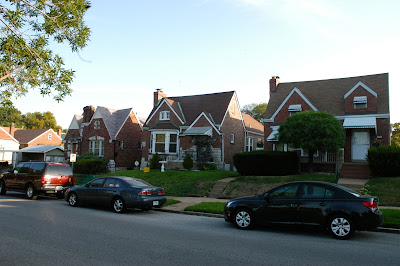The park is located southeast of Marcus and Margaretta Avenues in the Penrose Neighborhood.
So who was Tink Bradley other than a dude with a great nickname? Here's some info:
Source: "Discovering African American St. Louis: A Guide to Historic Sites
By John Aaron Wright
In fairness, I think it is important to recognize that Penrose is a part of the city that is in pretty bad shape. People are vacating like mad. There is zero diversity in this part of the city. Those with means started leaving more than 50 years ago. The neighborhood has been all black since 1970. The population in Penrose has gone from 7,367 in 2000 to 6,387 in 2010. Another 13% packed it up for greener pastures between 1990 and 2000. People are making a break from the conditions here and that is a massive loss for the city. Sadly, people don't like living here and they are voting with their feet and $.
While it's cool that Tink Bradley was the first acting black BOA president. It should be noted that during his tenure as an alderman, we lost a staggering amount of people in this city and particularly this part of the city. He was likely part of this problem and the general trend of St. Louis abandonment that took place in his time. The amazing losses during his tenure as alderman should be noted in the historical context. While he ruled the roost in these parts from 1965 - 1980 we lost 297,225 people. The worst part of the city's history was right in this time frame. People couldn't get out fast enough. Tink Bradley was at the helm during this time. His area went from middle class to something that is decidedly not even close today. This is not a character assassination at all, I just think it is important to think of our "recognized leaders" records in their time. Tink Bradley was on the one of those driving the bus when it steered west for the staid confines of the county.
| Historical populations | |||
|---|---|---|---|
| Census | Pop. | %± | |
| 1810 | 1,600 | ||
| 1830 | 4,977 | ||
| 1840 | 16,469 | 230.9% | |
| 1850 | 77,860 | 372.8% | |
| 1860 | 160,773 | 106.5% | |
| 1870 | 310,864 | 93.4% | |
| 1880 | 350,518 | 12.8% | |
| 1890 | 451,770 | 28.9% | |
| 1900 | 575,238 | 27.3% | |
| 1910 | 687,029 | 19.4% | |
| 1920 | 772,897 | 12.5% | |
| 1930 | 821,960 | 6.3% | |
| 1940 | 816,048 | −0.7% | |
| 1950 | 856,796 | 5.0% | |
| 1960 | 750,026 | −12.5% | |
| 1970 | 622,236 | −17.0% | |
| 1980 | 452,801 | −27.2% | |
| 1990 | 396,685 | −12.4% | |
| 2000 | 348,189 | −12.2% | |
| 2010 | 319,294 | −8.3% | |
| Est. 2012 | 318,172 | −0.4% | |
2012 Estimate[23] | |||
That's not to say the park isn't nice. It is almost the perfect size for the surrounding neighborhood. The topography blends down toward the playgrounds and forms a nice space.
There are some really weird concrete and stone structures left over from who knows what. If anyone has some info on this, please let me know. Upon my visit, there were no neighbors available to talk about the park.
There is a really nice fence that was recently installed. The locals have taken to tearing off the tops of the fence in many places.
There is other evidence of abuse including missing benches, trash everywhere and either burnt or removed rubber surfacing under the playground. It could also mean, they are re-surfacing the playground, but there was no evidence of work taking place:
There is a nice basketball court that has some of the most unique polls I've seen thus far.
The houses that surround the park range from completely trashed, to boarded up to quite nice little gingerbreads to new suburban homes built on cul-de-sacs.
This park also has a baseball diamond which appears not to be used.

















































